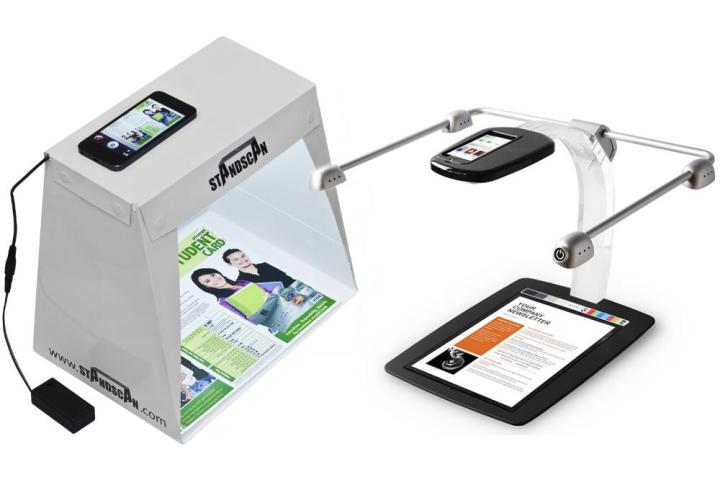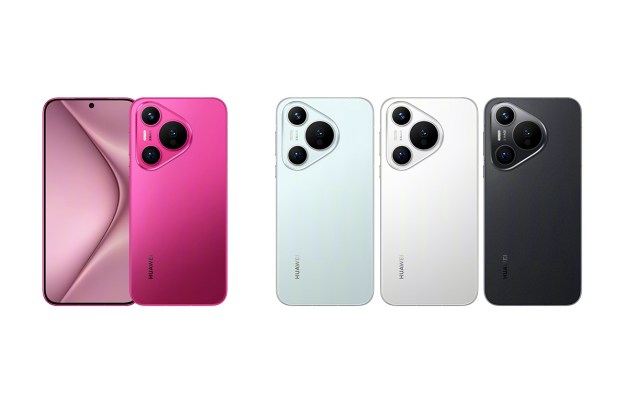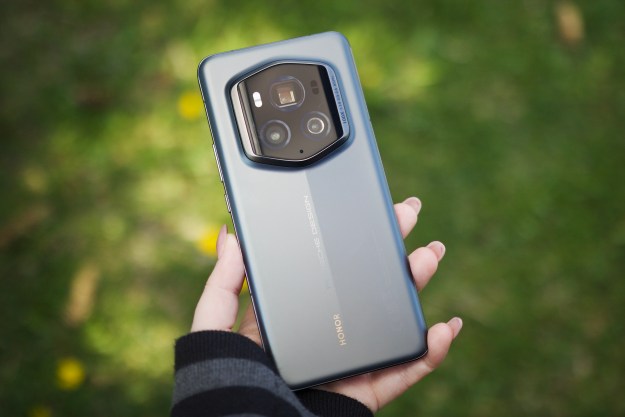
They’ve only been around a few years, but modern smartphones already take detailed enough photos to replace portable scanners. It’s now possible to generate a decent PDF of a document with an 8 – 13-megapixel shooter and the right app. In order to get the best result you need a steady hand, good lighting, and the right angle. Good apps can help by aligning a skewed image correctly, but getting a straight on shot is best. To solve that problem, there is a burgeoning category of smartphone scanner stands hitting the market. These accessories allow you to lay your phone on a flat surface at the right distance for capturing letter-sized paper.
Most scanner stands are like the $20 StandScan; simple cardboard (or plastic) tents that collapse or fold up in some way for easy porting and storage. And then there’s the ScanDock, which is in a class of it’s own. This study and more permanent-looking model bills itself as the Post-PC Scanner and promises higher quality. It also costs $400.
The ScanDock is clearly a product someone was clamoring for since it exists thanks to a successful KickStarter campaign. But is it so much better than basic scanner stands that it’s worth the high price? We tested the ScanDock and the StandScan head to head to find out.
How We Tested
We used the Samsung Galaxy S4‘s 13-megapixel camera to take the test scans. Since the StandScan doesn’t have its own app and the ScanDock’s Android app isn’t up to par at the moment, we used three third-party apps for the process. CamScanner, Google Drive Scan, and Evernote Page Capture. We scanned three types of documents: a print page from the book Chicks Dig Time Lords, a page of mixed text and images from Bomb magazine, and a handwritten page on lined paper. Since the ScanDock comes with lighting, we tested it against the StandScan Pro, which comes with integrated LEDs and costs $30.
Setup
For an accessory meant to work with small, mobile devices, the ScanDock is the complete opposite. It arrived in a large, heavy box and took us around 20 minutes to assemble (there are a lot of tiny screws). The dock has little actual bulk but takes up a lot of space. The 16 x 20 x 15-inch size takes up almost as much space as a compact all-in-one printer. We like the overall look, especially the “Crystal Neck” rising up from the base to the lighting arms and the phone platform.
The StandScan arrived in a legal-sized padded envelope. It’s designed to collapse and fold completely flat, so it will always fit into a big envelope even after you assemble it. It’s made out of thick, reinforced cardboard with magnets embedded in the edges. The magnets are what hold the box together and make it easy to disassemble when you’re done. Figuring out how to assemble the StandScan required accessing the long-forgotten part of our brain that does origami, even with the clear instructions. Once assembled, we found it sturdy enough to stay standing with a smartphone and a small tablet on top, just don’t lean on the thing. To power the lights, the StandScan Pro comes with a small and portable-friendly 9V battery pack. (If you pay an extra $8 you can get an A/C adapter and a AA battery pack, too.)
Notable design differences between the two – outside of the materials used – are that the surface area for scanning documents is smaller on the StandScan. The ScanDock is also 3 inches taller, opening up a wider angle for a smartphone to capture.
Head to Head Results: text, magazine, handwriting
We started with scanning a text page and right away noted a disadvantage of this type of scanning solution. Keeping books pressed down and in place is harder when there’s no lid to push down. Luckily, the scanning apps allowed us to crop the image so our finger wasn’t in the shot. With both devices we were able to focus quickly and scan with no problems.
ScanDock PDF Example 1, Example 2 | StandScan PDF Example 1, Example 2
Comparing the scanned documents, text came out crisper in the ScanDock samples than the StandScan ones. In both cases, the text is readable and good enough for OCR (optical character recognition), the ScanDock samples are just better.
Next we scanned the magazine page. We prioritized text readability over image quality when processing this one, so in each case the colorful images don’t look so great. The black and white line drawing and the text look far better. The glossy paper revealed a weakness with the StandScan.

ScanDock PDF Example 1, Example 2 | StandScan PDF Example 1, Example 2
The way the LEDs are placed on the StandScan makes them shine on one part of the paper more directly than the rest, and thus the text is washed out on one side and hard to read. The ScanDock’s eight LEDs are designed to spread light evenly; the magazine page looks much better in these PDFs. When we turned the StandScan’s LEDs off and used the phone’s flash the result was a bit better, but still not as good as the ScanDock.

Next we used Page Capture to scan a handwritten page into Evernote. When you do this, Evernote attempts to read your handwriting and index the words it finds for search. The results aren’t always perfect, but a better scan should theoretically yield better results. Search recognized more words from the StandScan capture than the ScanDock even though, to our eye, the latter scan is crisper.
Finally, we used the Galaxy S4’s Optical Reader app to capture the book page and convert it to editable text. In both cases the number of mistakes was minor and, between the two stands, the app made different mistakes. (See the text here.) The text from the ScanDock had more mistakes overall, though.
Apps and Features

Aside from the even lighting, the ScanDock incorporates a few other features designed to help produce better quality scans. Above the document area is a strip of colors called the Image IQ that aids in color correction. The ScanDock app is designed to utilize the Image IQ area, and on iOS the results are great. The Android app is in the Google Play Store but it’s not fully functional as of this posting. Another nice feature is the silicone Flat Mat. The sticky surface keeps documents flat but won’t stick to them permanently. Peeling them off does tend to curl them up, so don’t use this unless you have to or don’t care about the original document.
The StandScan doesn’t have an app, comes with no special features, and is pretty basic. It’s more portable than the ScanDock and the fact that it folds up flat and isn’t very heavy means students can take it to the library and scan pages from books instead of paying for copier service. The only drawback is that the StandScan isn’t open on both sides which can become a problem if you’re trying to scan large books. It’s possible open up the flap on the back to accommodate oversized items. The structure is less stable, though won’t collapse completely.
StandScan doesn’t feel very sturdy nor does it feel like it can stand up to repeated assembling and disassembling for long. It may last a school year but perhaps not beyond. At least buying a new one is not expensive.
Final Verdict: ScanDock wins, but costs too much
The ScanDock allowed us to create better scans and the even distribution of light is far superior to the StandScan’s LEDs. If you need a top-notch smartphone scanning solution, the ScanDock does provide that. Moreso if you use an iPhone than with Android. However, the results aren’t so much better that it justifies the $400 price tag for most people. We can see businesses wanting this in lieu of a scanner so everyone can use it without hassle, maybe. Just keep in mind that the ScanDock takes up more space than an actual scanner.
The StandScan is not as flashy or as sturdy, yet it held its own against a far more expensive accessory. You can make decent scans with this and then fold it up to stash away when you’re done or when you need to take it somewhere. If you anticipate scanning plain text documents, non-glossy paper, or small stuff like business cards, the StandScan will serve you well.



